Jonathan Baldock has created a structure to worship
nature between the temples of Mithras & finance
A new installation from artist Jonathan Baldock uses the
architecture of Kentish hop growing to create a structure dedicated to the worship
of nature & family. Using traditional & earthen materials, the artist
has created temple-like space acting as counter to both the ancient Roman Temple of
Mithras buried beneath & to the surrounding Norman Foster-designed
Bloomberg HQ, as explored by Will Jennings.
For all that the high-rise City of London is a
densely-packed architectural testament to the modern age, there are within it
glimpses of the world that went before. The street-level experience and
globally-recognised skyline is a jigsaw of towers by the likes of Richard
Rogers, Rafael Viñoly, Kohn Pedersen Fox and more but underneath and between
there are glimpses of pre-war, medieval, and more distant pasts that have all
led to the financial centre that exists today. A prominent example of this
layering of the city can be found underneath the £1bn European HQ of Bloomberg,
the Norman Foster-designed immaculately hewn compact block of a building that’s
bisected by a public route following the long-buried Walbrook River, gesturally
brought to the surface with Cristina Iglesias’ Forgotten Streams fountain sculptures (see 00047).
While the 10-storeys above are the epitome of 21st century engineering and polished architecture where thousands daily worship at the altar of high finance and the miraculous invisible hand of the market (the Bloomberg HQ was used as location for the recent HBO/BBC finance debauchery-drama Industry), the basement reveals the roots of it all through the remains of the Roman Temple of Mithras, directly connecting the London of today to the city of 1800 years ago.
![]()
![]()
![]()
There is little remaining, however, of the landscape before the settlement of Romans, before Londonium existed when the landscapes were continuous with those of modern-day Surrey, Essex, Sussex, and Kent. Some of that rural landscape and customs have been transplanted into the Bloomberg SPACE gallery as an act of introducing counter-myths to those of Mithras, below. Artist Jonathan Baldock has created an installation titled 0.1%, comprising textiles, clay sculptures, and an architectural framework filling the space.
At the centre of it all is a towering figure, a feminine anti-Mithras to bring a new energy into the space to work against the legacy of the Mithras cult and the idea of a warrior-hero. Temples of Mithreas, Mithraeum, were sunken, below ground, and represented the cave to which Mithras carried then killed the primordial bull in the cult’s creation myth. A chamber of fourteen columns forming seven sequential grades of the cult, the temple would have been visited by male members from the army, mercantile class, and civil servants as a space of bonding and ritual.
Above, Baldock has created a different architecture, one not based on structured patriarchal progression but one formed on a more open, fluid mode of navigation, and which at the centre features a goddess based upon the artist’s own mother. “When I was about five or six, I made a clay sculpture of my mum,” the artist says, “well, it was Kentish mud, which is very clay based, it was very small – it fits in the palm of your hand – and I had completely forgotten about it but my mum keeps things, and she pulled this out … it was 40 years since I'd seen it, but I remember making it.”
![]()
That clay sculpture is in the space, but it has grown in aesthetic material and stature, reflecting the change in Baldock from child- to adult-maker. The mud face has been scanned, enlarged, and formed in bronze with bright blue Lapis lazuli eyes. Under, a hessian dress cascades, adorned with decorative and symbolic patterns, giant-fingered hands add an otherworldly godlike quality, and hops spill out from the underside of it all.
The dress is made of the same material used for hop sacks, described by Baldock as an “overlooked, humble, and industrial material, but glammed up with symbolism and decoration that repeats across over works hanging around the space. The room is full of symbols, some of which speak to pagan and pre-Christian ideas of connecting to land and nature, with others designed by the artist in response to his own thinking about Kent, family, and invoking a new mythology rooted in maternal care, consideration, and connection rather than the violence below.
![]()
The timber and wire framework it’s all suspended from picks up the ordered rhythm of the temple below ground but in place of the pillars forming seven stages of devotion, creates a space of free navigation with no fixed destination or culmination. It is shaped around a scaled-up hop garden frame, formed of poles on which the plant stems can grow up to six metres a year. Twiddling wire is strung between the poles to create a matrix across which the hops can grow and intertwine. “They are made from coppiced poles, a technique used since the Stone Age that doesn't kill the tree, and which I find very beautiful as it opens up the woodland ground for the for snow drops and bluebells, says Baldock, adding “…one of my mum's favourite flowers.”
The title of the show, 0.1%, speaks to the tiny genetic difference between all of humanity, whether that’s shared humanity across the world right now or looking deeper into our collective past. The structures around the gallery are symbolic of that shared framework that unites everyone: “I'm aware of the layers and what I've tried to do is think about a bigger picture – yes, it starts from personal experience and I've lent into my family,” Baldock says. “I have a long line of agricultural labourers in my family and there's a really nice photo of my mum, me with a nice pink handbag I'm mincing around with, and then my nan, grandad, and aunt, and they’re all twining up. So, it's a generational thing and I love this idea of the hop garden as a sort of a metaphor.”
Family is central, even if the work looks across all humanity, and the artist’s mum is also present in the space elsewhere. Near the door, strung from the ceiling and looking across everybody who enters Bloomberg SPACE – whether to see Baldock’s show or passing through it on the way to the cult’s temple below ground – is a fantastical creature with butterfly-like wings, human body, and a lifelike cast of his mother’s face. “The love of the mum is basic, it goes beyond religion in a way, it's the first worship children have,” says Baldock of the piece which may have his mother’s features, but is symbolic of all mothers – the message on a wing reads “Tell Mum you love Her.”
![]()
![]()
![]()
![]()
Elsewhere, the installation features clay vessels that speak to ceremonial or religious objects, as well as drinking vessels used to store ale made from the very hops symbolised elsewhere in the piece – as well as referencing the various fragments of vessels and pots displayed on a nearby wall vitrine that acts as entrance to the stepped passage descending from contemporary gallery into ancient temple. All the materials in the show speak to Baldock’s long held interest in natural material and traditional processes as recessed.space previously saw with the artist’s corn-dolly masks in the group show Acts of Gatheringat the Eden Project (see 00130). A soundscape by Luke Barton floats around it all gently, creating the rural context but pushing and pulling in tune with the artworks.
Later this year, Baldock will present many more ceramic works at Jupiter Artland (see 00201) in a solo exhibition featuring: “a bunch of animals based around scientific studies into same-sex relationships – but I'm gonna fuck them up by making them slightly sort of folkloric, mythological, so they're gonna be little bit unicorny but, you know, Penguin-unicorns.” Baldock says it’s going to be weird, but “W-Y-R-D, which comes from an old Norse word” which is more connected to the supernatural, uncanny, idea of personal fate than the modern meaning of weird.
Across the Bloomberg show and Baldock’s other projects there is a recurring sense of a search for the magical and mythical within the modern, organised, and structured world, something he is looking for in landscape, customs, materials, family, and interconnected understanding. That these ideas are compacted between two spaces of historic and contemporary systems of worship and value – the cult of Mithras with its stone temple and neoliberal banking within the Norman Foster-designed temple – perhaps makes the presentation of these value systems even more powerful.
While the 10-storeys above are the epitome of 21st century engineering and polished architecture where thousands daily worship at the altar of high finance and the miraculous invisible hand of the market (the Bloomberg HQ was used as location for the recent HBO/BBC finance debauchery-drama Industry), the basement reveals the roots of it all through the remains of the Roman Temple of Mithras, directly connecting the London of today to the city of 1800 years ago.


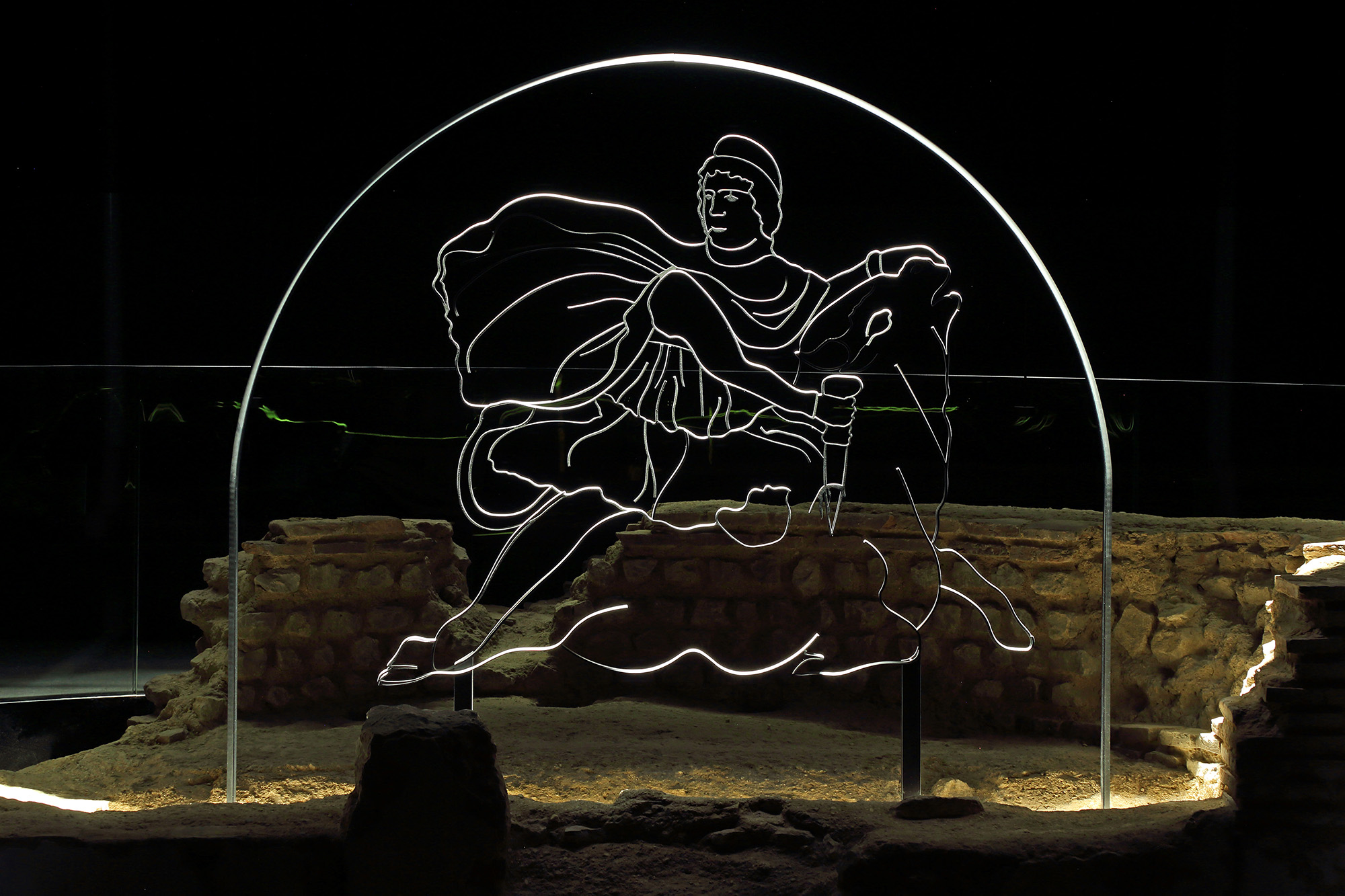
figs.i-iii
There is little remaining, however, of the landscape before the settlement of Romans, before Londonium existed when the landscapes were continuous with those of modern-day Surrey, Essex, Sussex, and Kent. Some of that rural landscape and customs have been transplanted into the Bloomberg SPACE gallery as an act of introducing counter-myths to those of Mithras, below. Artist Jonathan Baldock has created an installation titled 0.1%, comprising textiles, clay sculptures, and an architectural framework filling the space.
At the centre of it all is a towering figure, a feminine anti-Mithras to bring a new energy into the space to work against the legacy of the Mithras cult and the idea of a warrior-hero. Temples of Mithreas, Mithraeum, were sunken, below ground, and represented the cave to which Mithras carried then killed the primordial bull in the cult’s creation myth. A chamber of fourteen columns forming seven sequential grades of the cult, the temple would have been visited by male members from the army, mercantile class, and civil servants as a space of bonding and ritual.
Above, Baldock has created a different architecture, one not based on structured patriarchal progression but one formed on a more open, fluid mode of navigation, and which at the centre features a goddess based upon the artist’s own mother. “When I was about five or six, I made a clay sculpture of my mum,” the artist says, “well, it was Kentish mud, which is very clay based, it was very small – it fits in the palm of your hand – and I had completely forgotten about it but my mum keeps things, and she pulled this out … it was 40 years since I'd seen it, but I remember making it.”
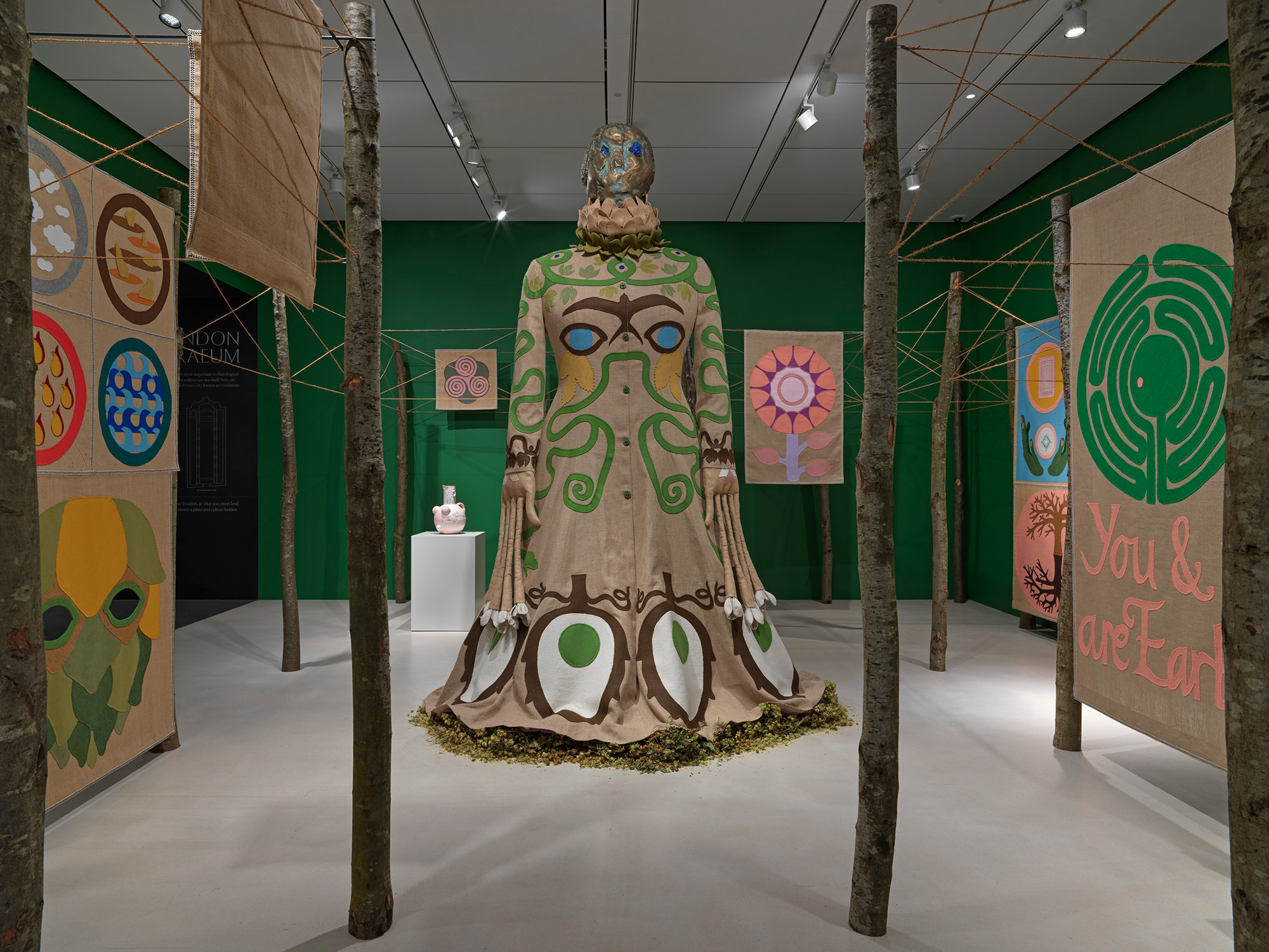
fig.iv
That clay sculpture is in the space, but it has grown in aesthetic material and stature, reflecting the change in Baldock from child- to adult-maker. The mud face has been scanned, enlarged, and formed in bronze with bright blue Lapis lazuli eyes. Under, a hessian dress cascades, adorned with decorative and symbolic patterns, giant-fingered hands add an otherworldly godlike quality, and hops spill out from the underside of it all.
The dress is made of the same material used for hop sacks, described by Baldock as an “overlooked, humble, and industrial material, but glammed up with symbolism and decoration that repeats across over works hanging around the space. The room is full of symbols, some of which speak to pagan and pre-Christian ideas of connecting to land and nature, with others designed by the artist in response to his own thinking about Kent, family, and invoking a new mythology rooted in maternal care, consideration, and connection rather than the violence below.
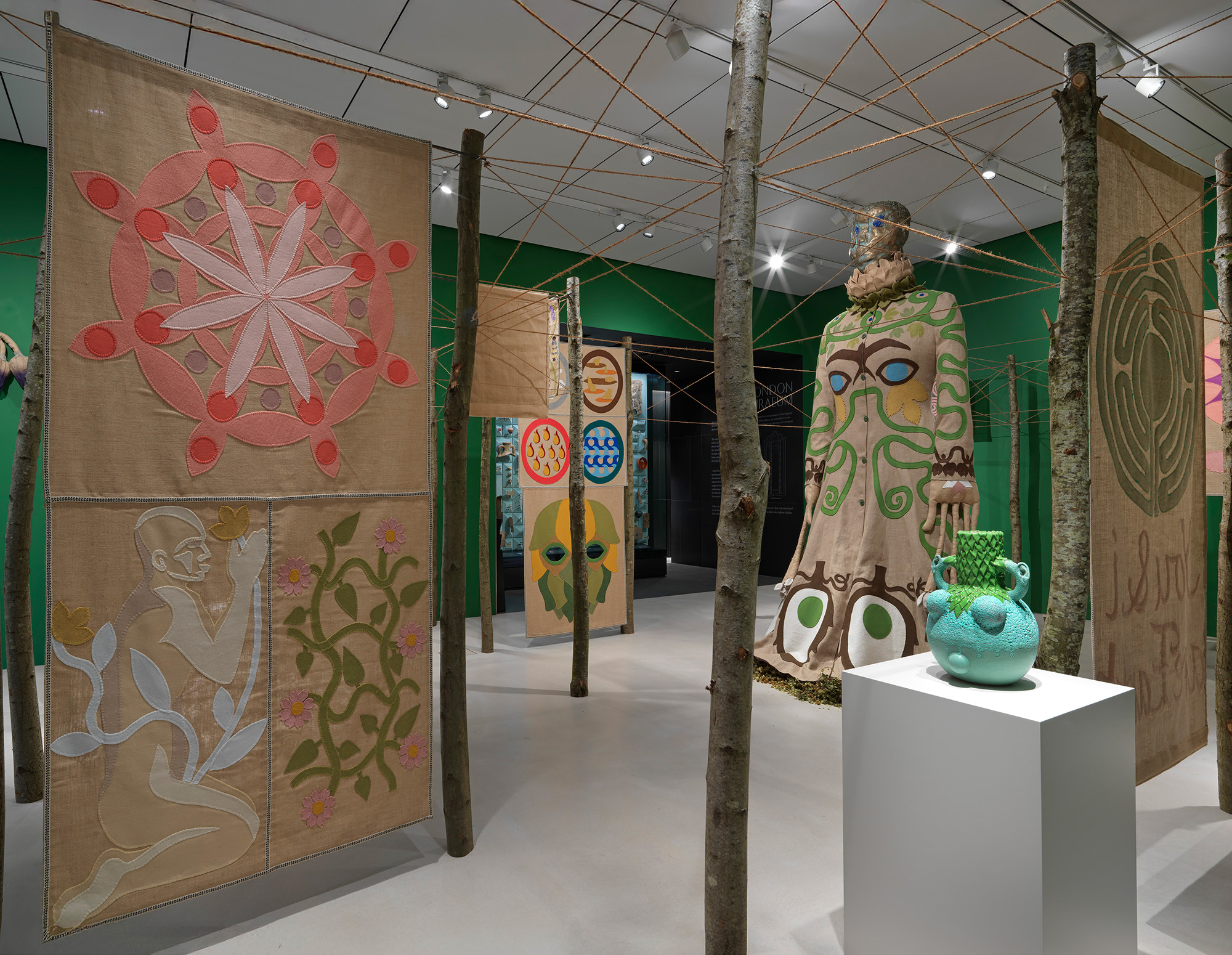
fig.v
The timber and wire framework it’s all suspended from picks up the ordered rhythm of the temple below ground but in place of the pillars forming seven stages of devotion, creates a space of free navigation with no fixed destination or culmination. It is shaped around a scaled-up hop garden frame, formed of poles on which the plant stems can grow up to six metres a year. Twiddling wire is strung between the poles to create a matrix across which the hops can grow and intertwine. “They are made from coppiced poles, a technique used since the Stone Age that doesn't kill the tree, and which I find very beautiful as it opens up the woodland ground for the for snow drops and bluebells, says Baldock, adding “…one of my mum's favourite flowers.”
The title of the show, 0.1%, speaks to the tiny genetic difference between all of humanity, whether that’s shared humanity across the world right now or looking deeper into our collective past. The structures around the gallery are symbolic of that shared framework that unites everyone: “I'm aware of the layers and what I've tried to do is think about a bigger picture – yes, it starts from personal experience and I've lent into my family,” Baldock says. “I have a long line of agricultural labourers in my family and there's a really nice photo of my mum, me with a nice pink handbag I'm mincing around with, and then my nan, grandad, and aunt, and they’re all twining up. So, it's a generational thing and I love this idea of the hop garden as a sort of a metaphor.”
Family is central, even if the work looks across all humanity, and the artist’s mum is also present in the space elsewhere. Near the door, strung from the ceiling and looking across everybody who enters Bloomberg SPACE – whether to see Baldock’s show or passing through it on the way to the cult’s temple below ground – is a fantastical creature with butterfly-like wings, human body, and a lifelike cast of his mother’s face. “The love of the mum is basic, it goes beyond religion in a way, it's the first worship children have,” says Baldock of the piece which may have his mother’s features, but is symbolic of all mothers – the message on a wing reads “Tell Mum you love Her.”
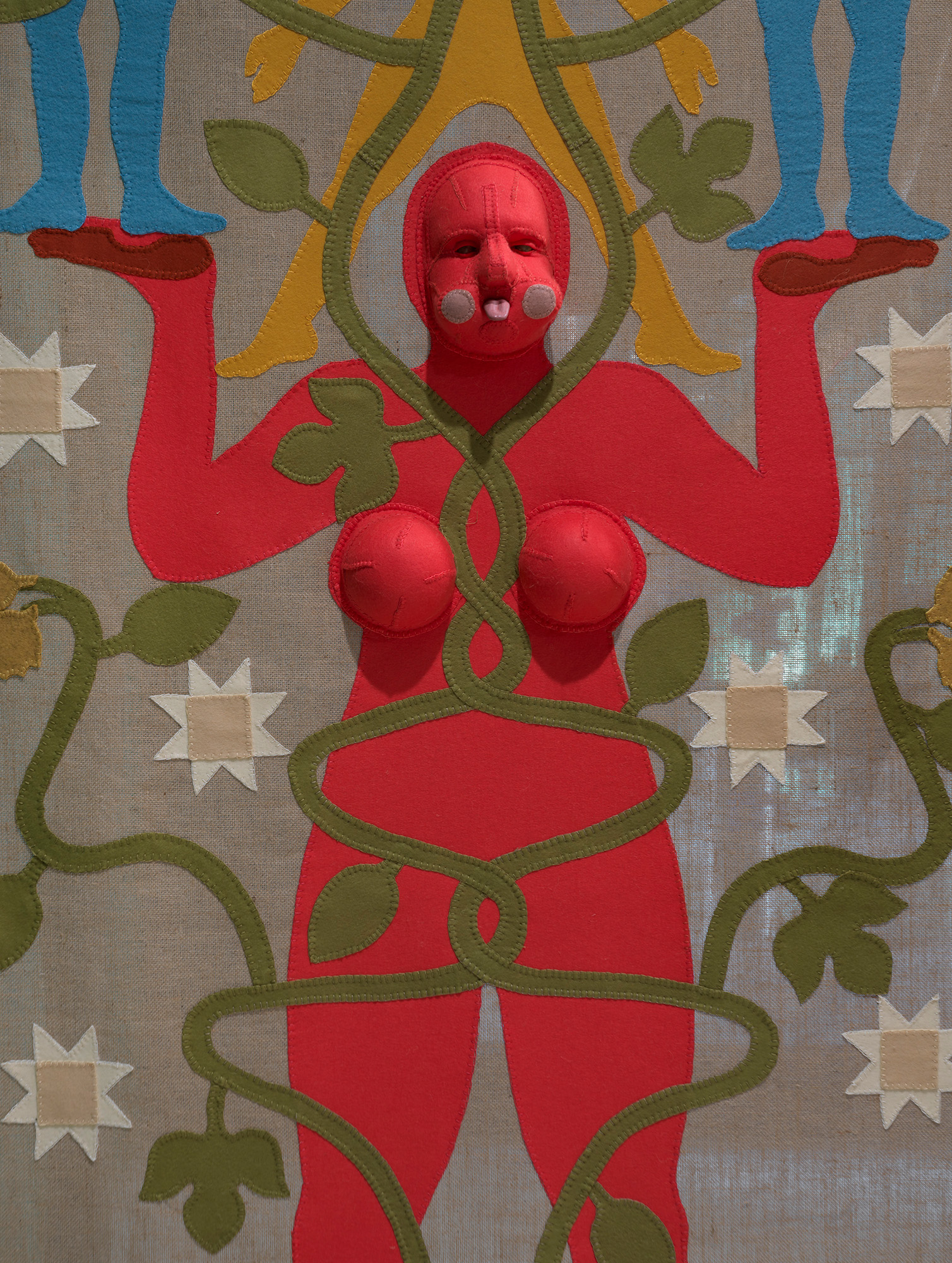
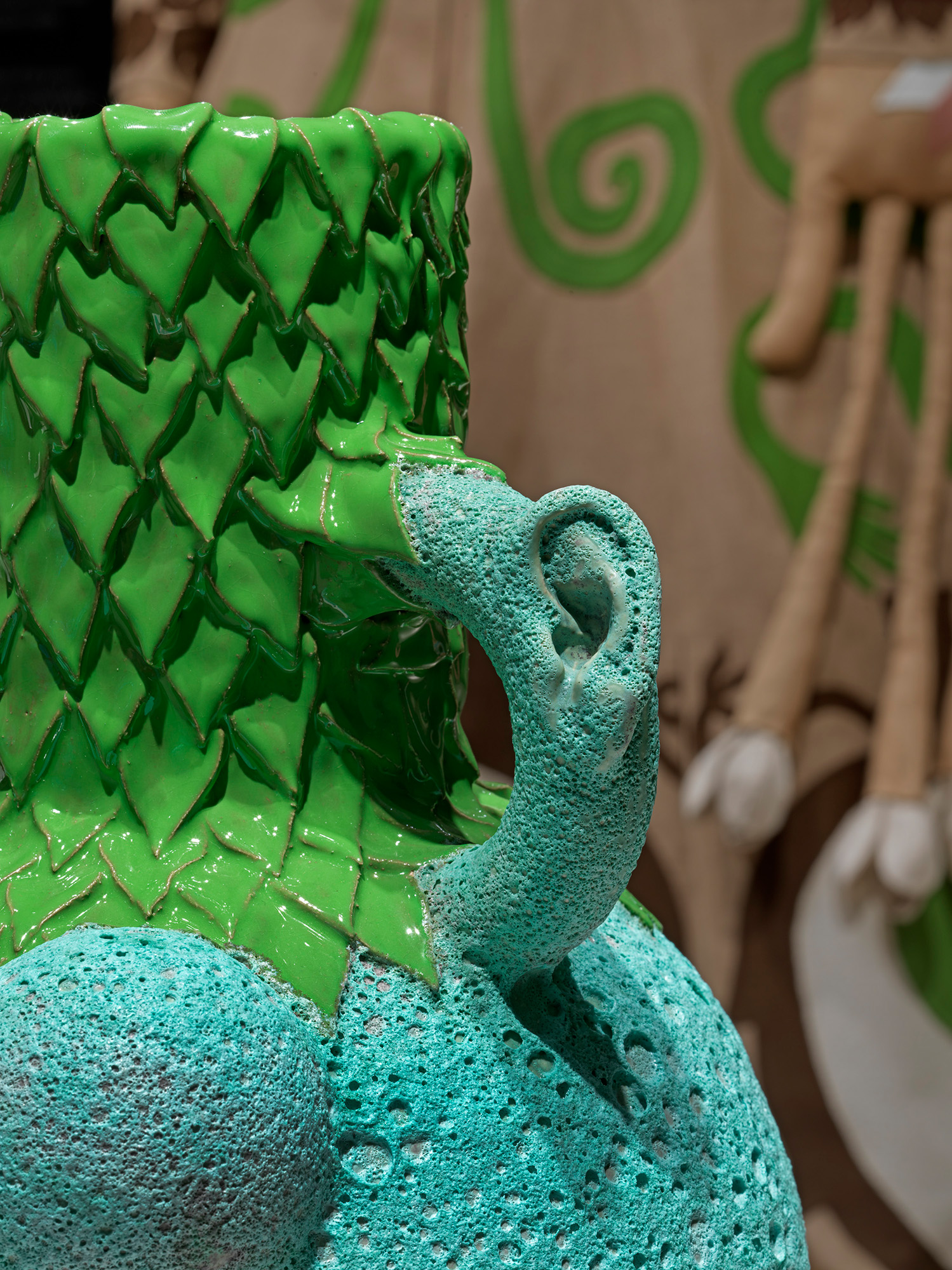
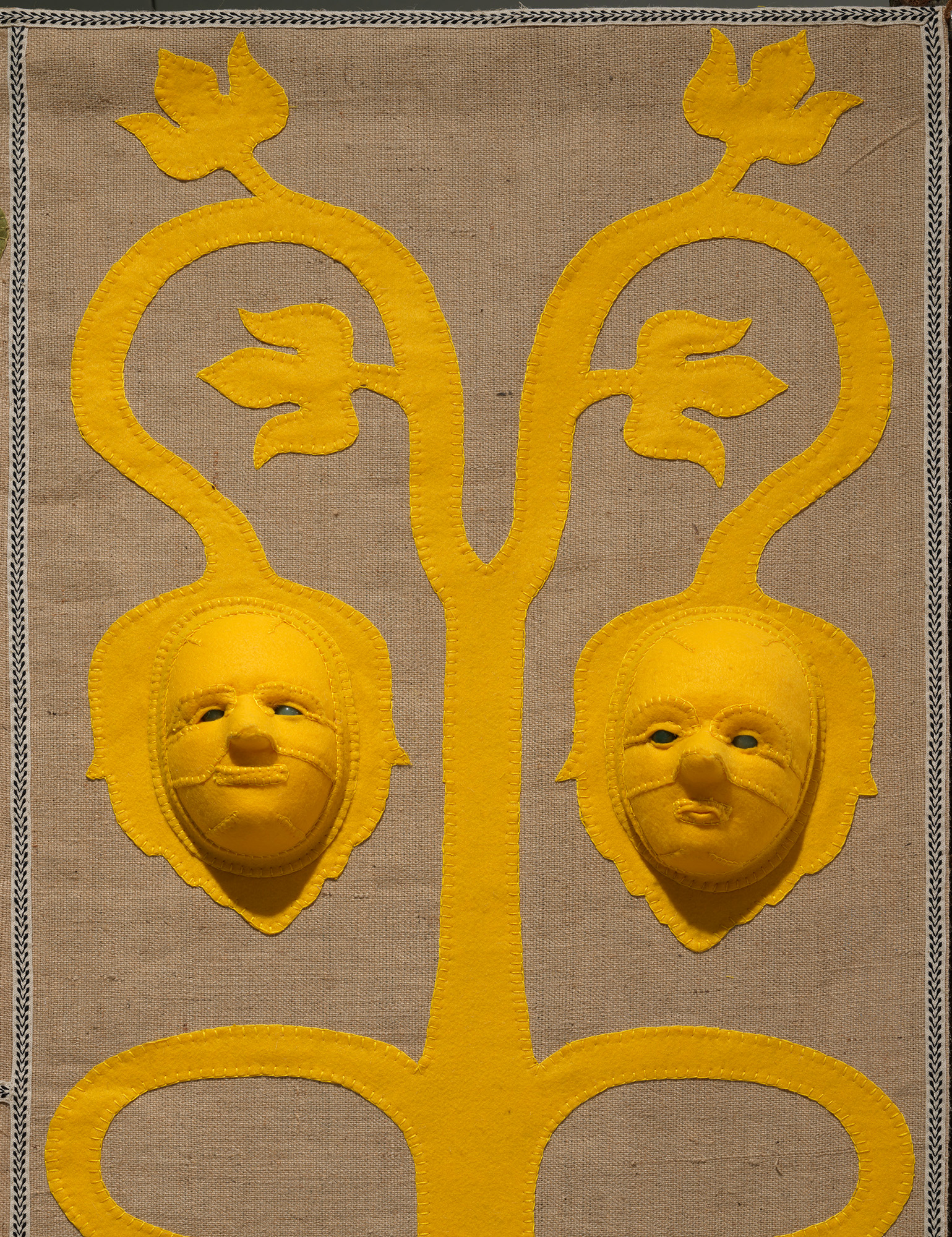
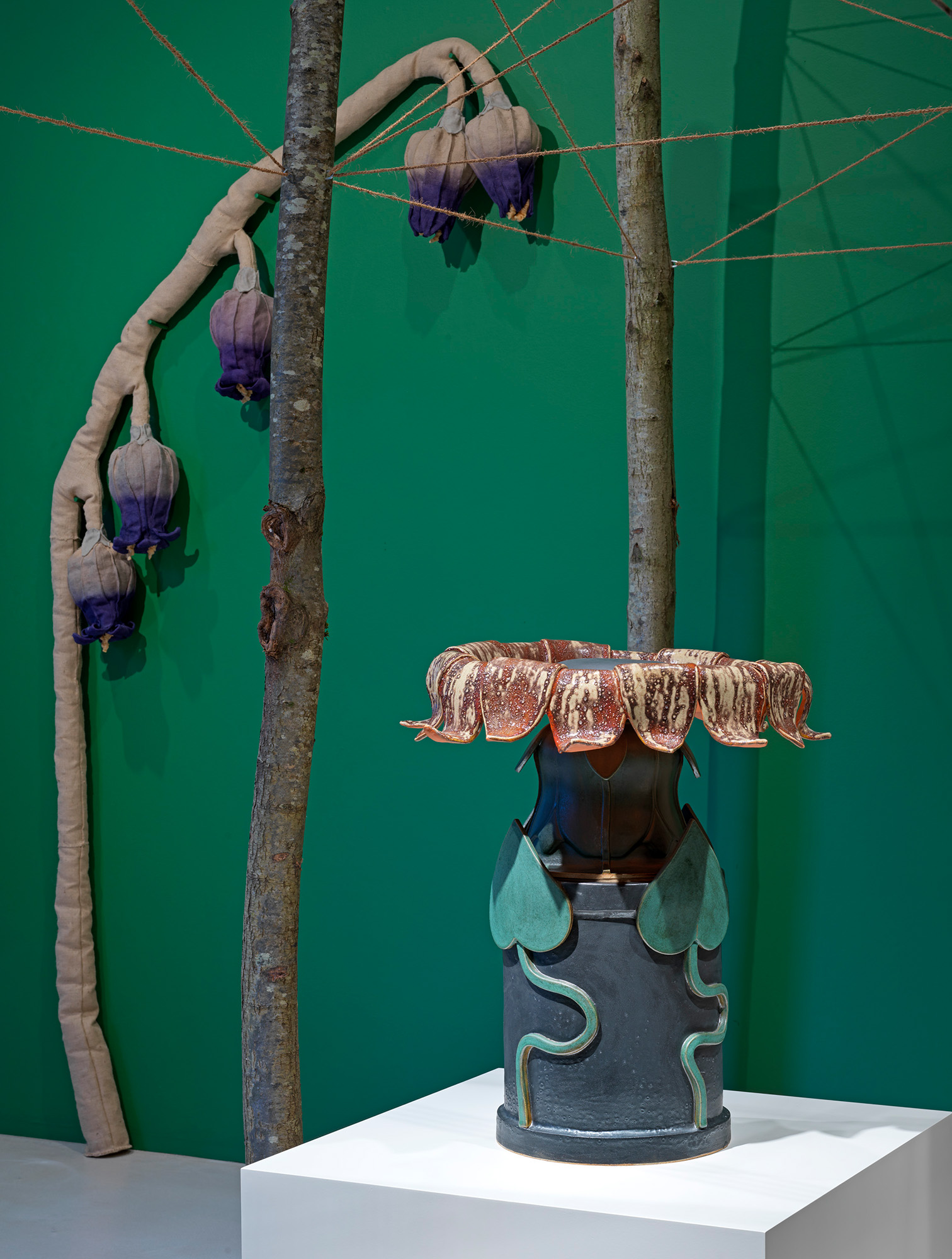
figs.vi-ix
Elsewhere, the installation features clay vessels that speak to ceremonial or religious objects, as well as drinking vessels used to store ale made from the very hops symbolised elsewhere in the piece – as well as referencing the various fragments of vessels and pots displayed on a nearby wall vitrine that acts as entrance to the stepped passage descending from contemporary gallery into ancient temple. All the materials in the show speak to Baldock’s long held interest in natural material and traditional processes as recessed.space previously saw with the artist’s corn-dolly masks in the group show Acts of Gatheringat the Eden Project (see 00130). A soundscape by Luke Barton floats around it all gently, creating the rural context but pushing and pulling in tune with the artworks.
Later this year, Baldock will present many more ceramic works at Jupiter Artland (see 00201) in a solo exhibition featuring: “a bunch of animals based around scientific studies into same-sex relationships – but I'm gonna fuck them up by making them slightly sort of folkloric, mythological, so they're gonna be little bit unicorny but, you know, Penguin-unicorns.” Baldock says it’s going to be weird, but “W-Y-R-D, which comes from an old Norse word” which is more connected to the supernatural, uncanny, idea of personal fate than the modern meaning of weird.
Across the Bloomberg show and Baldock’s other projects there is a recurring sense of a search for the magical and mythical within the modern, organised, and structured world, something he is looking for in landscape, customs, materials, family, and interconnected understanding. That these ideas are compacted between two spaces of historic and contemporary systems of worship and value – the cult of Mithras with its stone temple and neoliberal banking within the Norman Foster-designed temple – perhaps makes the presentation of these value systems even more powerful.
Jonathan Baldock was born in 1980 in Kent, UK. He lives and works in London. He graduated from Winchester School of Art with a BA in Painting (2000-2003), followed by the Royal College
of Art, London with an MA in Painting (2003-2005).
Saturated with humour and wit, as well as an uncanny, macabre quality that channels his longstanding interest in myth and folklore, Baldock has an ongoing focus on the contrast between
the material qualities of ceramic and fabric in his work. Concerned with removing the functional aspects of the materials he uses, the artist instead works in a performative way through his sculptural assemblages, bringing the viewer, the object and the space they simultaneously
occupy into question as a theatrical or ritualistic act.
Recent solo exhibitions include Touch Wood, Yorkshire Sculpture Park, Wakefield, UK (2023);
through the joy of the senses, Charleston Lewes, Sussex, UK (2023); Unearthed, Kunstverein
Göttingen, Germany (2023); we are flowers of one garden, Stephen Friedman Gallery, London,
UK (2023); I’m Still Learning, La Casa Encendida, Madrid, Spain (2021); Warm Inside, Accelerator, Stockholm, Sweden (2021); and Me, Myself and I, Kunsthall Stavanger, Norway (2020).
In the spring of 2019, Baldock’s solo exhibition Facecrime opened at Camden Arts Centre, London following a Freelands Lomax Ceramics Fellowship. The exhibition travelled to Tramway, Glasgow in August 2019 and Bluecoat, Liverpool in March 2020. Other notable solo and two-person exhibitions include LOVE LIFE: Act 3, De La Warr Pavilion, Bexhill, UK (2017); LOVE LIFE: Act 2, Grundy Art Gallery, Blackpool, UK (2017); There’s No Place Like Home, Southwark Park Galleries, London, UK (2017); LOVE LIFE: Act 1, PEER, London, UK (2016); The Soft Machine, Chapter Gallery, Cardiff, Wales, UK (2016) and A strange cross between
a butchers shop and a nightclub, Wysing Arts Centre, Cambridge, UK (2013).
www.jonathan-baldock.com
London Mithraeum Bloomberg SPACE is situated on the site of Bloomberg’s European headquarters and returns the Roman Temple of Mithras to the location of its discovery in the heart of the City and offers
visitors an immersive experience of the ancient temple as well as a chance to see a collection
of the Roman artefacts found during the building excavations. Expanding on Bloomberg’s legacy
of support for new commissions by international artists, the ground floor Bloomberg SPACE gallery
aims to present lively and thoughtful works by contemporary artists whilst bringing fresh perspectives
to the many-layered history of the site.
London Mithraeum Bloomberg SPACE is free to visit and open to the public from Tuesday to
Saturday from 10 am to 6 pm, and on Sundays and Bank Holidays from 12 pm to 5 pm.
www.londonmithraeum.com
Will Jennings is a London based writer, visual artist, and educator interested in cities, architecture, and culture. He has written for the RIBA Journal, the Journal of Civic Architecture, Quietus, The Wire, the Guardian, and Icon. He teaches history and theory at UCL Bartlett and Greenwich University, and is director of UK cultural charity Hypha Studios.
www.willjennings.info
to the many-layered history of the site.
London Mithraeum Bloomberg SPACE is free to visit and open to the public from Tuesday to
Saturday from 10 am to 6 pm, and on Sundays and Bank Holidays from 12 pm to 5 pm.
www.londonmithraeum.com
Will Jennings is a London based writer, visual artist, and educator interested in cities, architecture, and culture. He has written for the RIBA Journal, the Journal of Civic Architecture, Quietus, The Wire, the Guardian, and Icon. He teaches history and theory at UCL Bartlett and Greenwich University, and is director of UK cultural charity Hypha Studios.
www.willjennings.info
visit
Jonathan Baldock, 0.1%, is on at London Mithraeum Bloomberg SPACE until July 2025. Both the exhibition and the Temple of Mithras are free, but pre-booking is advised for the temple:
www.londonmithraeum.com/bloomberg-space-jonathan-baldock
images
fig.i
Temple
of Mithras dig 1954. Photo by Robert Hitchman
©
MOLA.
fig.ii
London
Mithraeum uses light sculpture, haze and sound to bring the temple’s remains to
life.
Photo
©
James Newton.
fig.iii
Scene
of Mithras slaying bull – tauroctony. © PAYE Conservation
figs.iv-ix Jonathan Baldock, 0.1%, at London Mithraeum Bloomberg SPACE. Photo © Marcus Leith
publication date
06 February 2025
tags
Agriculture, Archaeology, Jonathan Baldock, Bloomberg, Clay, Cult, Family, Norman Foster, History, Hops, Will Jennings, Kent, Lapis lazuli, London, Mithraeum, Mithras, Mother, Mythology, Nature, Roman, Sculpture, Temple, Walbrook River
www.londonmithraeum.com/bloomberg-space-jonathan-baldock


